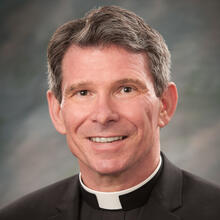A Homily for the Solemnity of the Immaculate Conception of the Blessed Virgin Mary
Readings: Genesis 3:9-15-20 Ephesians 1:3-6, 11-12 Luke 1:26-38
Sometimes a truth is more than misunderstood. It is stood on its head. A good example is the dogma of the Immaculate Conception. To say that Mary was conceived without original sin, our fundamental alienation from God, is not to say that she did not need a savior nor that she is set above us. As Christ does with us, he graced Mary before she merited it, and God does not love some of us more than others.
No, the good news at the center of this teaching is how deep our salvation runs. In her newest novel, The Books of Jacob (2022), Nobel Prize laureate Olga Tokarczuk sets one of her innumerable scenes before the Black Madonna of Częstochowa. This meditative passage suggests that, like that of her Christ, the wealth poured into Mary was always destined to be poured out.
Jesus is God’s initiative: free from all sin, yet dying for all sin. Mary is our response.
She writes on a scrap of paper: “If you are truly merciful, bring them back to life.” She sprinkles it with sand and waits for the ink to dry, then she rolls the paper up tight. She keeps this little roll in her hands as she enters the chapel. It is cold, and there are not many pilgrims, so she walks down the middle, going up as close as she is allowed, as close as the barriers will permit her. To her left, a legless soldier, with disheveled hair that looks like hank of hemp, whimpers. He can’t even kneel. His uniform is ruined, its buttons long since replaced, the aiguillettes torn off, no doubt to be used for something else. Behind him is an elderly woman wrapped in headscarves, with a little girl whose face is misshapen by a purple lump. One of her eyes is almost completely obscured under that proud flesh. Drużbacka kneels nearby and prays to the covered picture.
She has had all of her jewelry melted down and fashioned into a big heart, not knowing how else to express her pain. She has a hole in her chest, and she must be mindful of it; it hurts and oppresses her. And she had cast a prosthesis out of gold, a crutch for the heart. Now she makes a votive offering of it in the monastery, and the monks hang it alongside the other hearts. She doesn’t know why, but the sign of the heart joined with the other hearts, big and small, brings Drużbacka the greatest relief, greater than prayer and greater than gazing into the black, impenetrable face of the Madonna. There is so much pain on view here, in this place. Every human tear enters a stream that flows into a little river, and the river joins a bigger river, and so on, until the end, in the great current of an enormous river it washes into the sea and dissolves on the horizon. In these hearts hung up around the Madonna, Drużbacka sees mothers who have lost, or are losing, or will lose their children and grandchildren. And in some sense, life is this constant loss. Improving one’s station, getting richer, is the greatest illusion. In reality, we are richest at the moment of our birth; after that, we begin to lose everything. That is what the Madonna represents: the initial whole, the divine unity of us, the world and God, is something that must be lost. What remains in its wake is just a flat picture, a dark patch of a face, an apparition, an illusion. The symbol of life is after all the cross, suffering—nothing more. This is how she explains it to herself.
If Mary did not need a savior, if she was conceived without sin to be set above us, she paid a horrible price for such privilege when she saw her son lifted from the earth, when the rivulets of his blood smattered onto her face.
But the Immaculate Conception is not about privilege. It proclaims how deep salvation runs. Jesus is God’s initiative: free from all sin, yet dying for all sin. Mary is our response. She knows no stain of sin because the savior reaches that deeply into our humanity. Yet with God’s grace and her consent, her suffering will be added to his, just as ours is when we yield to grace.
In reality, we are richest at the moment of our birth; after that, we begin to lose everything. That is what the Madonna represents: the initial whole, the divine unity of us, the world and God, is something that must be lost.
All is grace. Nothing stands free of the savior, save that which must: the consent of this woman, and our own. God pours all wealth away and invites us to do the same.








